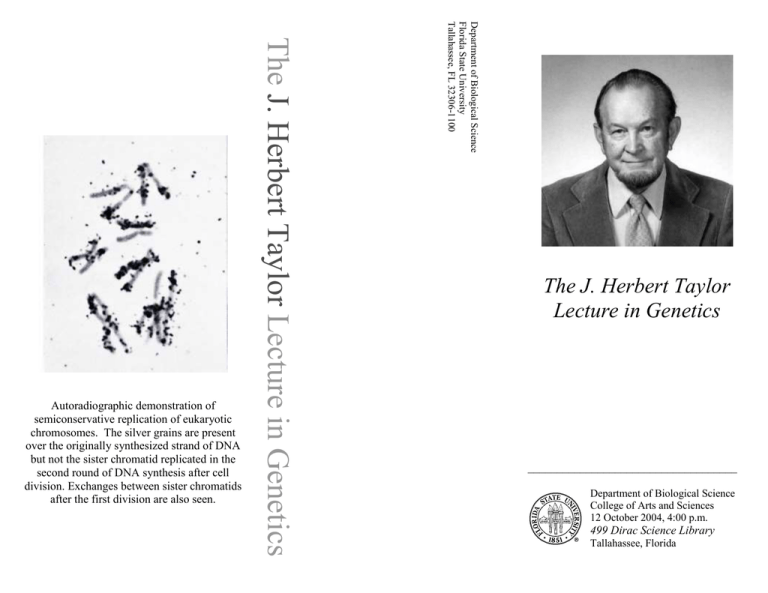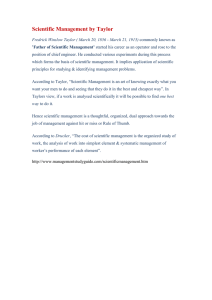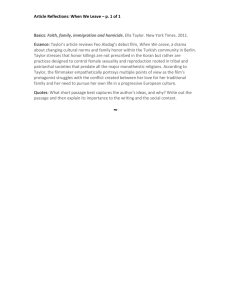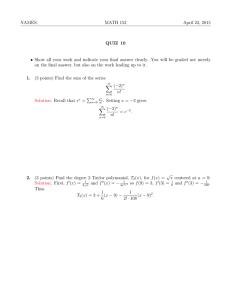The Lect ure in G
advertisement

Department of Biological Science Florida State University Tallahassee, FL 32306-1100 The J. Herbert Taylor Lecture in Genetics Autoradiographic demonstration of semiconservative replication of eukaryotic chromosomes. The silver grains are present over the originally synthesized strand of DNA but not the sister chromatid replicated in the second round of DNA synthesis after cell division. Exchanges between sister chromatids after the first division are also seen. The J. Herbert Taylor Lecture in Genetics ____________________________________ Department of Biological Science College of Arts and Sciences 12 October 2004, 4:00 p.m. 499 Dirac Science Library Tallahassee, Florida “Maternally controlled processes and morphogenetics of zebrafish development” MARY C. MULLINS, University of Pennsylvania Dr. J. Herbert Taylor was Robert O. Lawton Distinguished Professor of Biology at Florida State University and a former director of the Institute for Molecular Biophysics. Dr. Taylor’s career spanned more than 50 years, during a time of phenomenal change in the fields of genetics and cell biology. He published more than 100 papers on chromosome structure and reproduction. In recognition of a lifetime of work, he was elected to the National Academy of Sciences of the USA in 1977. In 1956, he provided the first and some of the most compelling evidence that DNA of eukaryotic chromosomes was synthesized and segregated in a semiconservative fashion, confirming the model of DNA synthesis proposed by Watson and Crick. Equally important were his demonstration of sister chromatid exchange―as not just a rare, esoteric phenomenon but a common event—and his discovery that one of the X-chromosomes in mammalian cells was late replicating―predating and helping to confirm Lyons’ theory of Xinactivation. Taylor’s experiments were innovative, but above all they were elegant in their simplicity and clarity. The autoradiographic techniques Herb Taylor developed with his wife and colleague Shirley Hoover Taylor opened an entirely new area of investigation of chromosome replication. Dr. Taylor graduated from Southeastern Oklahoma State University in 1939. He earned a master’s degree from the University of Oklahoma and a Ph.D. from the University of Virginia. After serving for four years in the army, he began his faculty career at the University of Oklahoma, moving to the University of Tennessee and Oak Ridge National Laboratory, and then to Columbia University, associating with Brookhaven National Laboratory. In 1964, Dr. Taylor joined the faculty of Florida State University, where he continued to work on the problems of DNA replication. He was a founding member of the American Society for Cell Biology, serving as its president in 1969, and a charter member of the Biophysics Society. Herb had a fascination with the natural world around him. He and Shirley enjoyed canoeing trips, picking wild blueberries, identifying plants beside the trail, trips to some of the wilder parts of the world, and family camping trips with their children, Lynne, Michael, and Lucy, as much as he enjoyed his science. ________________________________________ Dr. Mullins received her B.S. in biochemistry from the University of Wisconsin, Madison, and her Ph.D. in 1989 from the University of California, Berkeley, where she studied transposition of the P-element in Drosophila. Dr. Mullins completed postdoctoral training in the laboratory of Dr. Christiane Nüsslein-Volhard, Max Planck Institute, Tübingen, Germany. She was appointed Assistant Professor of Cell and Developmental Biology at the University of Pennsylvania. Today, Dr. Mullins is an Associate Professor at Penn and conducts research into the genetic mechanisms regulating pattern formation in the vertebrate embryo. She is Co-Director for the Marine Biological Laboratory’s course “Neurodevelopment and Genetics of Zebrafish.” Currently, her laboratory’s projects address the maternal components that contribute to early embryonic development. Dr. Taylor died at his home in December 1998. Shirley Taylor died in August of this year. The J. Herbert Taylor Lecture in Genetics the Department of Biological Science, Florida State University; 12 October 2004, 4:00 p.m., 499 Dirac Science Library


